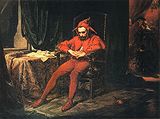- Polish culture in the Interbellum
-
Part of a series on the Culture of Poland Periods Middle Ages Renaissance Baroque Enlightenment Romanticism Positivism Young Poland Interbellum World War II People's Republic of Poland Modern Arts Cinema Literature Music Theatre Practitioners Artists Authors Composers Musicians Painters Poets
Poland Portal
Polish culture in the Interbellum period witnessed a time of rebirth, as Polish culture was no longer suppressed by partitioners. It saw the retreat of the 19th century elite cultures of nobility as well as the traditional folk culture, and rise of a new mass culture, close to inteligentsia, integrating the new Polish society.[1]
Polish culture was differentiated between the three former partitions. The territories of the Prussian partition were most developed, while east and south territories - parts of the former Russian partition and Austrian partition - were among the least developed regions in Europe.[1] Over time, the cultural hubs of Warsaw, Kraków, Wilno (modern Vilnius) and Lwów (modern Lviv) raised themselves to the level of major European cities.
While the term Polish culture refers primarily to the Polish language culture in Poland and in other countries, Second Polish Republic had also several vibrant national minorities: most notably Jewish, Ukrainian, Belorussian, Lithuanian and German. To a degree that varied depending on time and particular ethnic group, those minorities where shunned by the mainstream Polish culture and subject to polonization policies.
Contents
References
See also
External links
Further reading
- Bolesław Klimaszewski, An Outline History of Polish Culture, Interpress, 1984, ISBN 8322320361
Categories:- Polish history stubs
- Cultural history of Poland
- History of Poland (1918–1939)
Wikimedia Foundation. 2010.

